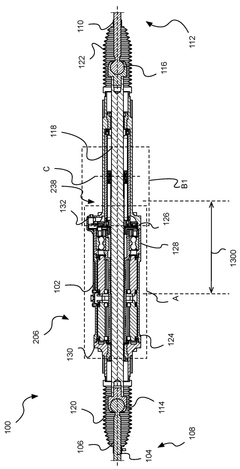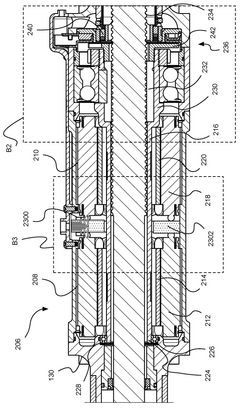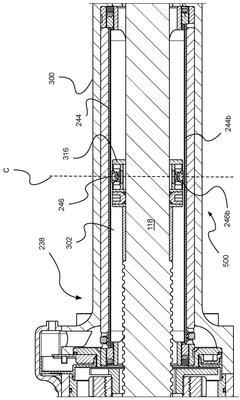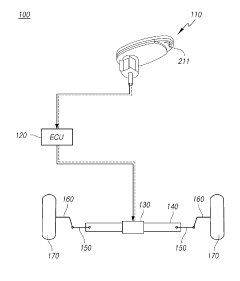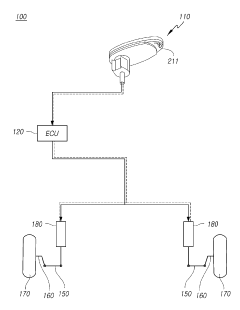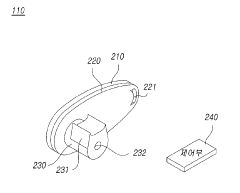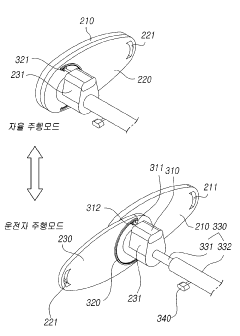Steering Wheel Technologies: Leading Change in Automotive Industry
JUL 18, 20259 MIN READ
Generate Your Research Report Instantly with AI Agent
Patsnap Eureka helps you evaluate technical feasibility & market potential.
Steering Wheel Evolution and Objectives
The steering wheel has been an integral part of automotive control since the inception of the automobile. Its evolution reflects the broader technological advancements in the automotive industry, from simple mechanical devices to sophisticated interfaces incorporating multiple functions and technologies.
In the early days of automobiles, steering wheels were purely mechanical, designed for the sole purpose of directing the vehicle. As cars became more complex, the steering wheel's role expanded. The mid-20th century saw the integration of horn buttons and basic controls for lights and wipers into the steering wheel, marking the beginning of its transformation into a multifunctional interface.
The late 20th and early 21st centuries brought significant changes to steering wheel technology. The introduction of power steering systems made steering easier and more responsive. Airbags integrated into steering wheels became standard safety features, dramatically improving occupant protection in frontal collisions.
Recent years have seen a rapid acceleration in steering wheel technology. The integration of electronic systems has led to the development of steering wheels with embedded controls for infotainment systems, cruise control, and voice commands. Advanced driver assistance systems (ADAS) have further expanded the steering wheel's capabilities, with features like lane-keeping assist and adaptive cruise control often controlled through the steering wheel.
The current technological landscape is pushing steering wheel design towards even greater sophistication. Haptic feedback systems are being incorporated to provide drivers with tactile alerts and information. Capacitive touch sensors and gesture recognition technologies are enabling more intuitive and less distracting interactions with vehicle systems.
Looking forward, the objectives for steering wheel technologies are multifaceted. One primary goal is to enhance safety by improving the driver's situational awareness and reducing distractions. This includes the development of steering wheels that can monitor driver alertness and provide warnings or interventions when necessary.
Another key objective is to prepare for the transition to autonomous vehicles. As cars become increasingly automated, the steering wheel's role is likely to evolve. Concepts for retractable or stowable steering wheels are being explored for vehicles that can switch between manual and autonomous modes.
Sustainability is also becoming a significant focus in steering wheel development. Manufacturers are exploring eco-friendly materials and production processes to reduce the environmental impact of steering wheel production.
In conclusion, the evolution of steering wheel technologies reflects a broader trend towards more intelligent, connected, and user-centric automotive design. The objectives driving this evolution aim to create steering systems that are safer, more intuitive, and adaptable to the changing nature of driving in the age of automation and environmental consciousness.
In the early days of automobiles, steering wheels were purely mechanical, designed for the sole purpose of directing the vehicle. As cars became more complex, the steering wheel's role expanded. The mid-20th century saw the integration of horn buttons and basic controls for lights and wipers into the steering wheel, marking the beginning of its transformation into a multifunctional interface.
The late 20th and early 21st centuries brought significant changes to steering wheel technology. The introduction of power steering systems made steering easier and more responsive. Airbags integrated into steering wheels became standard safety features, dramatically improving occupant protection in frontal collisions.
Recent years have seen a rapid acceleration in steering wheel technology. The integration of electronic systems has led to the development of steering wheels with embedded controls for infotainment systems, cruise control, and voice commands. Advanced driver assistance systems (ADAS) have further expanded the steering wheel's capabilities, with features like lane-keeping assist and adaptive cruise control often controlled through the steering wheel.
The current technological landscape is pushing steering wheel design towards even greater sophistication. Haptic feedback systems are being incorporated to provide drivers with tactile alerts and information. Capacitive touch sensors and gesture recognition technologies are enabling more intuitive and less distracting interactions with vehicle systems.
Looking forward, the objectives for steering wheel technologies are multifaceted. One primary goal is to enhance safety by improving the driver's situational awareness and reducing distractions. This includes the development of steering wheels that can monitor driver alertness and provide warnings or interventions when necessary.
Another key objective is to prepare for the transition to autonomous vehicles. As cars become increasingly automated, the steering wheel's role is likely to evolve. Concepts for retractable or stowable steering wheels are being explored for vehicles that can switch between manual and autonomous modes.
Sustainability is also becoming a significant focus in steering wheel development. Manufacturers are exploring eco-friendly materials and production processes to reduce the environmental impact of steering wheel production.
In conclusion, the evolution of steering wheel technologies reflects a broader trend towards more intelligent, connected, and user-centric automotive design. The objectives driving this evolution aim to create steering systems that are safer, more intuitive, and adaptable to the changing nature of driving in the age of automation and environmental consciousness.
Market Demand Analysis
The steering wheel market is experiencing significant growth and transformation, driven by the rapid evolution of automotive technologies and changing consumer preferences. As vehicles become more advanced and connected, the demand for sophisticated steering wheel systems has surged. This trend is particularly evident in the premium and luxury vehicle segments, where consumers expect cutting-edge features and enhanced driving experiences.
The global automotive steering wheel market is projected to expand at a compound annual growth rate (CAGR) of over 4% from 2021 to 2026. This growth is primarily fueled by the increasing adoption of advanced driver assistance systems (ADAS) and the integration of smart technologies into steering wheels. The market is also benefiting from the rising production of electric vehicles (EVs) and autonomous vehicles, which often incorporate innovative steering wheel designs and functionalities.
One of the key drivers of market demand is the growing emphasis on vehicle safety. Steering wheels equipped with airbags and other safety features are becoming standard across various vehicle segments. Additionally, the integration of haptic feedback systems and touch-sensitive controls in steering wheels is gaining traction, enhancing driver awareness and reducing distractions.
The shift towards autonomous driving technologies is reshaping the steering wheel market. While fully autonomous vehicles may eventually eliminate the need for traditional steering wheels, the transition period is creating demand for adaptive and retractable steering wheel systems. These innovative designs allow for seamless switching between manual and autonomous driving modes, catering to evolving consumer needs and regulatory requirements.
Another significant trend influencing market demand is the integration of infotainment controls into steering wheels. Consumers increasingly expect easy access to audio, communication, and navigation functions without taking their hands off the wheel. This has led to the development of multi-function steering wheels with intuitive control layouts and customizable interfaces.
The COVID-19 pandemic has had a mixed impact on the steering wheel market. While it initially caused disruptions in the automotive supply chain and production, it has also accelerated the adoption of contactless technologies. This shift has created new opportunities for steering wheel manufacturers to develop innovative, hygienic solutions such as antimicrobial coatings and touch-free control systems.
Regionally, Asia-Pacific is expected to dominate the steering wheel market, driven by the rapid growth of the automotive industry in countries like China and India. North America and Europe are also significant markets, with a strong focus on technological advancements and luxury vehicle production. The increasing demand for electric vehicles in these regions is further propelling the adoption of advanced steering wheel technologies.
The global automotive steering wheel market is projected to expand at a compound annual growth rate (CAGR) of over 4% from 2021 to 2026. This growth is primarily fueled by the increasing adoption of advanced driver assistance systems (ADAS) and the integration of smart technologies into steering wheels. The market is also benefiting from the rising production of electric vehicles (EVs) and autonomous vehicles, which often incorporate innovative steering wheel designs and functionalities.
One of the key drivers of market demand is the growing emphasis on vehicle safety. Steering wheels equipped with airbags and other safety features are becoming standard across various vehicle segments. Additionally, the integration of haptic feedback systems and touch-sensitive controls in steering wheels is gaining traction, enhancing driver awareness and reducing distractions.
The shift towards autonomous driving technologies is reshaping the steering wheel market. While fully autonomous vehicles may eventually eliminate the need for traditional steering wheels, the transition period is creating demand for adaptive and retractable steering wheel systems. These innovative designs allow for seamless switching between manual and autonomous driving modes, catering to evolving consumer needs and regulatory requirements.
Another significant trend influencing market demand is the integration of infotainment controls into steering wheels. Consumers increasingly expect easy access to audio, communication, and navigation functions without taking their hands off the wheel. This has led to the development of multi-function steering wheels with intuitive control layouts and customizable interfaces.
The COVID-19 pandemic has had a mixed impact on the steering wheel market. While it initially caused disruptions in the automotive supply chain and production, it has also accelerated the adoption of contactless technologies. This shift has created new opportunities for steering wheel manufacturers to develop innovative, hygienic solutions such as antimicrobial coatings and touch-free control systems.
Regionally, Asia-Pacific is expected to dominate the steering wheel market, driven by the rapid growth of the automotive industry in countries like China and India. North America and Europe are also significant markets, with a strong focus on technological advancements and luxury vehicle production. The increasing demand for electric vehicles in these regions is further propelling the adoption of advanced steering wheel technologies.
Current Challenges
The steering wheel, a critical interface between driver and vehicle, is undergoing significant transformation in the automotive industry. However, this evolution is not without its challenges. One of the primary hurdles is the integration of advanced technologies while maintaining user-friendly interfaces. As steering wheels become more sophisticated, incorporating touch-sensitive controls and digital displays, there's a risk of overwhelming drivers with information and options, potentially compromising safety.
Another significant challenge lies in balancing automation with driver engagement. As vehicles move towards higher levels of autonomy, the role of the steering wheel is being redefined. Manufacturers must navigate the complex task of designing steering systems that can seamlessly transition between manual and autonomous modes, ensuring drivers remain alert and ready to take control when necessary.
Regulatory compliance presents another obstacle. Different regions have varying safety standards and regulations regarding steering wheel design and functionality. This creates a complex landscape for manufacturers aiming to produce globally marketable vehicles, necessitating adaptable designs that can meet diverse regulatory requirements.
Cost considerations also pose a substantial challenge. Implementing cutting-edge technologies in steering wheels, such as haptic feedback systems or integrated biometric sensors, can significantly increase production costs. Manufacturers must find ways to incorporate these advanced features while keeping vehicles affordable for consumers.
Durability and reliability remain critical concerns. As steering wheels incorporate more electronic components, they become more susceptible to wear and potential malfunctions. Ensuring these high-tech steering systems can withstand the rigors of daily use and extreme conditions over the vehicle's lifespan is a significant engineering challenge.
The issue of cybersecurity has also come to the forefront. With steering wheels increasingly connected to vehicle networks and potentially to external systems, they become potential entry points for cyber attacks. Protecting these critical control systems from unauthorized access or manipulation is paramount for ensuring vehicle safety and consumer trust.
Lastly, there's the challenge of user acceptance and adaptation. Traditional drivers may resist radical changes to steering wheel design or functionality. Manufacturers must carefully balance innovation with familiarity, ensuring that new technologies enhance rather than disrupt the driving experience. This requires extensive user testing and iterative design processes to create steering systems that are both advanced and intuitive.
Another significant challenge lies in balancing automation with driver engagement. As vehicles move towards higher levels of autonomy, the role of the steering wheel is being redefined. Manufacturers must navigate the complex task of designing steering systems that can seamlessly transition between manual and autonomous modes, ensuring drivers remain alert and ready to take control when necessary.
Regulatory compliance presents another obstacle. Different regions have varying safety standards and regulations regarding steering wheel design and functionality. This creates a complex landscape for manufacturers aiming to produce globally marketable vehicles, necessitating adaptable designs that can meet diverse regulatory requirements.
Cost considerations also pose a substantial challenge. Implementing cutting-edge technologies in steering wheels, such as haptic feedback systems or integrated biometric sensors, can significantly increase production costs. Manufacturers must find ways to incorporate these advanced features while keeping vehicles affordable for consumers.
Durability and reliability remain critical concerns. As steering wheels incorporate more electronic components, they become more susceptible to wear and potential malfunctions. Ensuring these high-tech steering systems can withstand the rigors of daily use and extreme conditions over the vehicle's lifespan is a significant engineering challenge.
The issue of cybersecurity has also come to the forefront. With steering wheels increasingly connected to vehicle networks and potentially to external systems, they become potential entry points for cyber attacks. Protecting these critical control systems from unauthorized access or manipulation is paramount for ensuring vehicle safety and consumer trust.
Lastly, there's the challenge of user acceptance and adaptation. Traditional drivers may resist radical changes to steering wheel design or functionality. Manufacturers must carefully balance innovation with familiarity, ensuring that new technologies enhance rather than disrupt the driving experience. This requires extensive user testing and iterative design processes to create steering systems that are both advanced and intuitive.
Existing Solutions
01 Steering wheel control systems
Advanced control systems integrated into steering wheels, including electronic controls, sensors, and interfaces for various vehicle functions. These systems enhance driver interaction, safety, and vehicle control capabilities.- Steering wheel control systems: Advanced control systems integrated into steering wheels, including electronic controls, sensors, and interfaces for various vehicle functions. These systems enhance driver interaction, safety, and vehicle control by incorporating features such as adaptive steering, drive-by-wire technology, and customizable controls.
- Ergonomic and adjustable steering wheel designs: Innovative steering wheel designs focusing on ergonomics, adjustability, and comfort. These designs include features such as telescoping and tilting mechanisms, customizable grips, and shape-adaptive technologies to accommodate different driving styles and preferences, enhancing driver comfort and control.
- Steering wheel safety enhancements: Safety-focused technologies integrated into steering wheels, including airbag systems, impact-absorbing materials, and collision detection sensors. These enhancements aim to improve driver and passenger safety in the event of accidents or sudden maneuvers.
- Steering wheel-integrated display and infotainment systems: Integration of display screens, touch-sensitive surfaces, and infotainment controls directly into the steering wheel. These systems provide drivers with easy access to vehicle information, navigation, communication, and entertainment features without taking their hands off the wheel.
- Autonomous and semi-autonomous steering technologies: Advanced steering technologies designed for autonomous and semi-autonomous vehicles, including systems that can transition between manual and automated steering modes. These technologies incorporate AI-driven decision-making, advanced sensors, and adaptive control algorithms to enhance vehicle autonomy and safety.
02 Adjustable steering wheel mechanisms
Mechanisms that allow for adjusting the position of the steering wheel to accommodate different drivers and improve ergonomics. These include tilt, telescoping, and memory functions for personalized settings.Expand Specific Solutions03 Steering wheel safety features
Technologies focused on improving driver and passenger safety, such as airbag integration, impact-absorbing materials, and collapsible steering columns designed to minimize injury in the event of a collision.Expand Specific Solutions04 Steering wheel materials and manufacturing
Innovations in materials and manufacturing processes for steering wheels, including lightweight composites, sustainable materials, and advanced production techniques to enhance durability, comfort, and aesthetics.Expand Specific Solutions05 Smart steering wheel interfaces
Integration of smart technologies into steering wheels, such as touch-sensitive surfaces, haptic feedback, voice control, and display screens. These interfaces provide enhanced connectivity and access to vehicle information and entertainment systems.Expand Specific Solutions
Key Industry Players
The steering wheel technology market is in a dynamic growth phase, driven by increasing demand for advanced automotive features. The market size is expanding rapidly, with major players like GM, Nissan, and BYD investing heavily in research and development. Technological maturity varies across different aspects of steering wheel innovations. Established companies such as Bosch and Autoliv are leading in traditional steering systems, while newer entrants like Chassis Autonomy SBA AB are pushing boundaries in autonomous driving technologies. The competitive landscape is diverse, with automotive giants, specialized suppliers, and tech-focused startups all vying for market share in this evolving sector.
GM Global Technology Operations LLC
Technical Solution: GM has been at the forefront of steering wheel innovation with its Super Cruise hands-free driving technology. The system uses a camera-based driver attention system mounted on the steering column to ensure the driver remains attentive even when not holding the wheel[4]. GM has also developed an advanced steering wheel with integrated controls and displays. This includes a light bar at the top of the steering wheel that changes color to indicate the status of the autonomous driving system[5]. Furthermore, GM has been exploring retractable steering wheel designs for future autonomous vehicles, allowing for a more flexible interior space when full self-driving capabilities are engaged[6].
Strengths: Advanced integration of autonomous driving features, innovative driver monitoring, adaptable designs for future mobility. Weaknesses: High cost of implementation, potential for system complexity leading to reliability issues, regulatory challenges for new designs.
Nissan Motor Co., Ltd.
Technical Solution: Nissan has developed a steer-by-wire system called Direct Adaptive Steering (DAS). This technology replaces the mechanical connection between the steering wheel and tires with electronic controls, allowing for more precise steering and reduced vibration[7]. The system can adjust steering ratios based on vehicle speed and driving conditions, enhancing both comfort and performance. Nissan has also integrated this technology with their ProPILOT autonomous driving system, allowing for smoother operation during assisted driving modes[8]. Additionally, Nissan has been working on shape-shifting steering wheel concepts that can transform between driving and autonomous modes, providing a more intuitive interface for different levels of vehicle control[9].
Strengths: Enhanced steering precision, improved ride comfort, seamless integration with autonomous systems. Weaknesses: Potential for electronic failures, higher maintenance costs, driver adaptation to new steering feel.
Innovative Steering Technologies
A steer-by-wire steering assembly
PatentWO2025080185A1
Innovation
- A steer-by-wire steering assembly with a housing, a motor assembly, a screw actuator, a rotor carrier sleeve, and a sensor assembly that includes a sensor housing and a sensor channel to ensure proper linear movement and prevent rotation of the steering shaft, along with redundant sensor assemblies for increased reliability.
Transforming steering wheel and steering apparatus including the same and driving method thereof
PatentActiveKR1020190111233A
Innovation
- A deformable steering wheel design with grip members that can unfold or fold around a coupling shaft member, controlled by an electronic unit, allowing the steering wheel to adapt to different driving modes and providing a wider space in autonomous driving and easier steering in manual modes.
Safety Regulations
Safety regulations play a crucial role in shaping the development and implementation of steering wheel technologies in the automotive industry. As vehicles become increasingly advanced and autonomous, regulatory bodies worldwide are adapting their guidelines to ensure the safety of drivers, passengers, and pedestrians.
The National Highway Traffic Safety Administration (NHTSA) in the United States has been at the forefront of establishing safety standards for steering systems. These regulations cover various aspects, including steering control, steering column displacement, and impact protection. The Federal Motor Vehicle Safety Standard (FMVSS) 203 and 204 specifically address steering column injuries in frontal collisions, mandating energy-absorbing designs to minimize the risk of chest injuries.
In the European Union, the United Nations Economic Commission for Europe (UNECE) has developed regulations such as UN Regulation No. 12, which focuses on the protection of drivers against the steering mechanism in the event of an impact. These regulations have led to the widespread adoption of collapsible steering columns and energy-absorbing steering wheels across the automotive industry.
As advanced driver assistance systems (ADAS) and autonomous driving technologies continue to evolve, regulatory bodies are working to update their guidelines. The NHTSA has released guidelines for automated driving systems, which include considerations for steering control in various levels of automation. Similarly, the European Union has introduced regulations for automated lane-keeping systems (ALKS), which have implications for steering wheel design and functionality.
The integration of steer-by-wire systems, which replace traditional mechanical linkages with electronic controls, has prompted regulators to develop new safety standards. These systems must demonstrate fail-safe mechanisms and redundancy to ensure vehicle control is maintained in the event of system failures. The ISO 26262 standard for functional safety in road vehicles provides a framework for developing and validating such safety-critical electronic systems.
As the industry moves towards fully autonomous vehicles, discussions are underway regarding the potential removal of steering wheels in certain vehicle designs. Regulatory bodies are grappling with the implications of this shift, considering factors such as emergency override capabilities and the need for manual control in specific situations. The NHTSA has begun the process of adapting its regulations to accommodate vehicles without traditional manual controls, including steering wheels.
Cybersecurity has emerged as a critical concern in modern steering systems, particularly with the increasing connectivity of vehicles. Regulatory bodies are developing guidelines to address potential vulnerabilities and ensure the integrity of steering controls against cyber threats. The UN Regulation No. 155 on Cyber Security and Cyber Security Management System sets requirements for manufacturers to implement cybersecurity measures in their vehicle systems, including those related to steering control.
The National Highway Traffic Safety Administration (NHTSA) in the United States has been at the forefront of establishing safety standards for steering systems. These regulations cover various aspects, including steering control, steering column displacement, and impact protection. The Federal Motor Vehicle Safety Standard (FMVSS) 203 and 204 specifically address steering column injuries in frontal collisions, mandating energy-absorbing designs to minimize the risk of chest injuries.
In the European Union, the United Nations Economic Commission for Europe (UNECE) has developed regulations such as UN Regulation No. 12, which focuses on the protection of drivers against the steering mechanism in the event of an impact. These regulations have led to the widespread adoption of collapsible steering columns and energy-absorbing steering wheels across the automotive industry.
As advanced driver assistance systems (ADAS) and autonomous driving technologies continue to evolve, regulatory bodies are working to update their guidelines. The NHTSA has released guidelines for automated driving systems, which include considerations for steering control in various levels of automation. Similarly, the European Union has introduced regulations for automated lane-keeping systems (ALKS), which have implications for steering wheel design and functionality.
The integration of steer-by-wire systems, which replace traditional mechanical linkages with electronic controls, has prompted regulators to develop new safety standards. These systems must demonstrate fail-safe mechanisms and redundancy to ensure vehicle control is maintained in the event of system failures. The ISO 26262 standard for functional safety in road vehicles provides a framework for developing and validating such safety-critical electronic systems.
As the industry moves towards fully autonomous vehicles, discussions are underway regarding the potential removal of steering wheels in certain vehicle designs. Regulatory bodies are grappling with the implications of this shift, considering factors such as emergency override capabilities and the need for manual control in specific situations. The NHTSA has begun the process of adapting its regulations to accommodate vehicles without traditional manual controls, including steering wheels.
Cybersecurity has emerged as a critical concern in modern steering systems, particularly with the increasing connectivity of vehicles. Regulatory bodies are developing guidelines to address potential vulnerabilities and ensure the integrity of steering controls against cyber threats. The UN Regulation No. 155 on Cyber Security and Cyber Security Management System sets requirements for manufacturers to implement cybersecurity measures in their vehicle systems, including those related to steering control.
Human-Machine Interface
The Human-Machine Interface (HMI) in steering wheel technologies represents a critical intersection between driver and vehicle, playing a pivotal role in shaping the future of automotive control systems. As vehicles become increasingly sophisticated, the steering wheel has evolved from a simple mechanical device to a complex interface integrating multiple functions and technologies.
Modern steering wheels incorporate a range of features designed to enhance driver interaction and vehicle control. Touch-sensitive surfaces allow drivers to access various vehicle functions without removing their hands from the wheel. These surfaces can be programmed to control infotainment systems, adjust climate settings, or manage driver assistance features. Haptic feedback mechanisms provide tactile responses to driver inputs, improving the user experience and reducing the need for visual confirmation.
Voice recognition technology integrated into steering wheels enables hands-free control of vehicle systems, enhancing safety by minimizing driver distraction. Advanced natural language processing algorithms allow for more intuitive and conversational interactions between the driver and the vehicle's systems.
Biometric sensors embedded in the steering wheel can monitor the driver's vital signs, such as heart rate and stress levels. This data can be used to detect driver fatigue or health emergencies, triggering appropriate safety measures or alerts. Some systems can even adjust vehicle settings based on the driver's physiological state to optimize comfort and safety.
Customizable displays integrated into the steering wheel provide real-time information on vehicle status, navigation, and driver assistance systems. These displays can be configured to show different information based on driver preferences or driving conditions, ensuring that critical data is always within the driver's line of sight.
Gesture recognition technology is being explored as a potential addition to steering wheel interfaces. This would allow drivers to control certain vehicle functions through predefined hand movements, further reducing the need for physical buttons or switches.
As autonomous driving technologies advance, the role of the steering wheel is evolving. Some concept vehicles feature retractable steering wheels that can be stowed away during autonomous operation, transforming the driver's area into a more versatile space. This adaptability reflects the changing nature of human-vehicle interaction in the era of autonomous driving.
The integration of augmented reality (AR) with steering wheel interfaces is an emerging trend. AR overlays can project navigation instructions, hazard warnings, or other relevant information onto the driver's view, enhancing situational awareness without requiring the driver to look away from the road.
Human-Machine Interface design in steering wheel technologies must balance functionality with simplicity to avoid overwhelming the driver. Ergonomic considerations are paramount to ensure that all controls are easily accessible and intuitive to use. As these interfaces become more complex, designers must prioritize user-centric approaches to maintain safety and usability.
Modern steering wheels incorporate a range of features designed to enhance driver interaction and vehicle control. Touch-sensitive surfaces allow drivers to access various vehicle functions without removing their hands from the wheel. These surfaces can be programmed to control infotainment systems, adjust climate settings, or manage driver assistance features. Haptic feedback mechanisms provide tactile responses to driver inputs, improving the user experience and reducing the need for visual confirmation.
Voice recognition technology integrated into steering wheels enables hands-free control of vehicle systems, enhancing safety by minimizing driver distraction. Advanced natural language processing algorithms allow for more intuitive and conversational interactions between the driver and the vehicle's systems.
Biometric sensors embedded in the steering wheel can monitor the driver's vital signs, such as heart rate and stress levels. This data can be used to detect driver fatigue or health emergencies, triggering appropriate safety measures or alerts. Some systems can even adjust vehicle settings based on the driver's physiological state to optimize comfort and safety.
Customizable displays integrated into the steering wheel provide real-time information on vehicle status, navigation, and driver assistance systems. These displays can be configured to show different information based on driver preferences or driving conditions, ensuring that critical data is always within the driver's line of sight.
Gesture recognition technology is being explored as a potential addition to steering wheel interfaces. This would allow drivers to control certain vehicle functions through predefined hand movements, further reducing the need for physical buttons or switches.
As autonomous driving technologies advance, the role of the steering wheel is evolving. Some concept vehicles feature retractable steering wheels that can be stowed away during autonomous operation, transforming the driver's area into a more versatile space. This adaptability reflects the changing nature of human-vehicle interaction in the era of autonomous driving.
The integration of augmented reality (AR) with steering wheel interfaces is an emerging trend. AR overlays can project navigation instructions, hazard warnings, or other relevant information onto the driver's view, enhancing situational awareness without requiring the driver to look away from the road.
Human-Machine Interface design in steering wheel technologies must balance functionality with simplicity to avoid overwhelming the driver. Ergonomic considerations are paramount to ensure that all controls are easily accessible and intuitive to use. As these interfaces become more complex, designers must prioritize user-centric approaches to maintain safety and usability.
Unlock deeper insights with Patsnap Eureka Quick Research — get a full tech report to explore trends and direct your research. Try now!
Generate Your Research Report Instantly with AI Agent
Supercharge your innovation with Patsnap Eureka AI Agent Platform!

